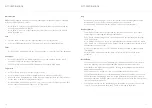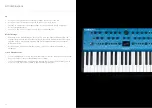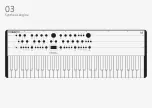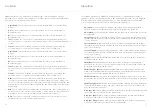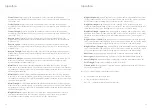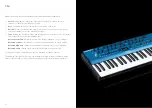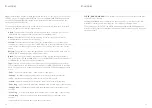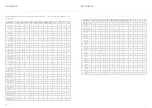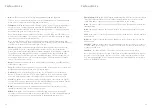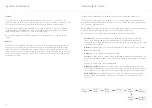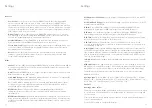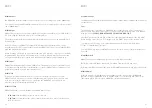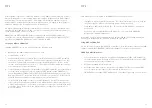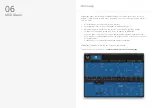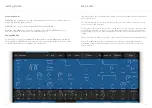
44
45
Modulation
COBALT8X has a comprehensive Modulation Matrix with 12 Modulation Sources and 55
Modulation destinations. These Mod slots can be used to assign a combination of modulation
sources to destinations, 8 modulation sources can be assigned to a single destination, or
any other combination thereof. There are also 4 preassigned slots for common modulation
routings. These preassigned modulations are:
•
Note>Cutoff:
Bipolar control to Increase or decrease how much key scaling is applied to
the cutoff frequency.
•
Y+>LFO1-Depth:
Increases LFO1-Depth with Y+ on Joystick, commonly used to set up
vibrato when LFO1 is controlling global pitch.
•
AftT>Cutoff:
Bipolar control to Increase or decrease filter cutoff frequency with
aftertouch.
•
Velo>AEG-Depth:
Increases amount of velocity applied to the AEG-Depth. Commonly
used as one way to increase velocity sensitivity of patches.
TIP: Try Velo>FEG-Depth for a more consistent, organic sounding velocity sensitivity.
The Mod Matrix is additive - Modulation values are added or subtracted from the modulated
parameter value and limited to the parameter range. If a parameter is at 0, negative
modulation values will not be audible until the parameter value is increased. The opposite is
true for parameters at max value.
All of the modulation depths are bipolar, meaning sources can be inverted using negative
depths.
When multiple mod slots are assigned to the same destination, the modulation from all
assigned slots is summed and limited before being applied.
LFO1, LFO2, LFO3, MOD-EG, Velo, AftT, Note, Expr, X+, X-, Y+, Y- can all be assigned to
destinations from the front panel by holding their buttons on the front panel and turning the
desired modulation destination encoder in a positive or negative direction.
Note. An LED flashing is used to indicate that the panel is in assign mode for the relative
function to that LED.
ModSlots can be viewed on-screen by using the Velo + ModSlot combination which also gives
access to screen only ModSlot Status control which allows you to activate or deactivate that
slot.
Modulation
•
Velo:
Pressing this button enters and exits the assign mode for velocity.
•
AftT:
Pressing this button enters and exits the assign mode for after touch.
•
Note:
Pressing this button enters and exits the assign mode for note / keytracking.
•
Expr:
Pressing this button enters and exits the assign mode for expression pedal.
•
X+:
Holding the ‘Shift’ button and (or when latched in shift mode) pressing this button
enters and exits the assign mode for Joystick X+.
•
X-:
Holding the ‘Shift’ button and (or when latched in shift mode) pressing this button
enters and exits the assign mode for Joystick X-.
•
Y+:
Holding the ‘Shift’ button and (or when latched in shift mode) pressing this button
enters and exits the assign mode for Joystick Y+.
•
Y-:
Holding the ‘Shift’ button and (or when latched in shift mode) pressing this button
enters and exits the assign mode for Joystick Y-.
•
XYLock:
Holding ‘Velo’ and pressing this button locks the Joystick in the position it is
held allowing you to let go and continue playing. Pressing this button again will unlock
the Joystick.
•
Sustain:
Holding ‘Velo’ and pressing this button enables MIDI sustain. Pressing this
button again disables MIDI sustain. Holding this button for one second when turning
on Sustain will enable Sustain ‘Latch Mode’ - press and release a note / chord to sustain
it, press a new note / chord to overwrite the existing one. This also works with the
arpeggiator and provides the classic arpeggiator ‘Hold’ functionality.
•
ModSlot:
Pressing this button navigates to the ModSlot page on-screen. Repeatedly
pressing this button cycles through all mod slot settings pages on the screen.
Holding any mod source button and turning the ‘Depth’ encoder allows you to set the
global depth for that mod source (pre-assigned mod routings are not affected by the source’s
global depth value). When the screen is displaying a mod slot ‘Depth’ parameter (most easily
accessed via assigning modulation using the panel or via the ModSlot button), hold the ‘Edit’
switch to clear the mod slot assignment.
To assign a mod source to an osc’s global frequency destination, use either of the fine tune
controls. ‘Tune1’ will assign to Osc1 tune, ‘Tune2’ will assign to Osc2 tune.
Summary of Contents for COBALT8X
Page 13: ...24 25 03 Synthesis engine...

